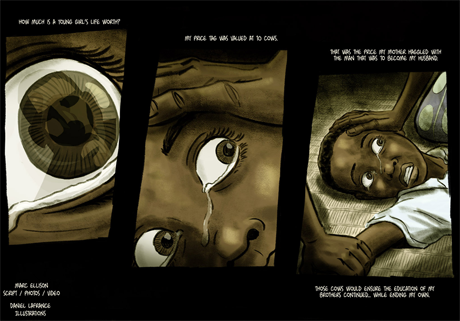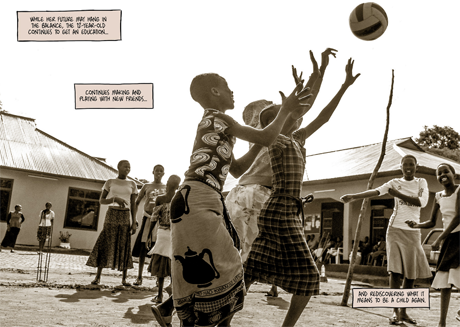
Warning: This piece includes materials some may find distressing.
The visual arts and storytelling have been intertwined throughout history, and illustrations continue to play an important role in the coverage of sensitive, deeply personal and often traumatic events.
"The graphic novel format allows me to basically plug gaps into time," explained photojournalist Marc Ellison, who has been working with a "graphic novel 2.0" format, a mixture of illustrations, stills and video.
Ellison covered the stories of child marriage and female genital mutilation survivors (FGM) in Northern Tanzania in his latest graphic novel Safe House, published by The Toronto Star at the beginning of April.
The format allowed him to grant anonymity to the young, vulnerable interviewees when needed, and portray their experiences of surviving abusive marriages, running away from home to escape the illegal practice of FGM, and their journey to the safe house in an accurate and softer way.
The videos were intended to keep audiences grounded and serve as a reminder that the report is not a work of fiction.
"Having the photos and video in there as well, it constantly reminds the reader if they were to forget that this is very much a real story, this isn't make-belief," Ellison told Journalism.co.uk in a recent podcast.
"After reading several pages of each person's story you might start to forget that this is very much a real person's story, a real person's tragedy. By injecting the occasional video and photo you're reminding the reader constantly that stories like these are sadly still happening in northern Tanzania."

Safe House is Ellison's second graphic novel, having previously covered the reintegration of former child soldiers into daily life in Uganda in Graphic Memories.
He included more videos in the first novel, but cut down on their number in Safe House to avoid distracting the readers from the main narrative thread.
"Looking at the analytics after it [Graphic Memories] was published, I noticed they didn't get a huge number of hits and I think that's a good and a bad thing.
"It's bad in the sense that there's a lot of great material in the videos that people are missing out on, but it's also good that people were really engaged in the story, in the narrative, and maybe they didn't want to click on the videos.
"With the Safe House graphic novel, I decided to not put in as many and like with the first graphic novel, I didn't want to force readers to watch them because I don't want to interrupt that flow of the storytelling.
"This time around I tried to cut down on the number of videos and really to only use the ones that I thought were particularly powerful," he explained.
So what's the process of creating a graphic novel? Ellison worked with illustrator Daniel Lafrance to create Safe House, although Lafrance did not travel to Tanzania.
Ellison took reference photographs and details for Lafrance, to help accurately portray the surroundings and the events the girls were recounting. Aside from these considerations, Ellison highlighted the reporting process was not very different from that of a regular foreign reporting trip.
The hard part started after he returned from Tanzania – writing the script for the graphic novel, storyboarding it with the artist, editing the videos and stills, and building the website.
For Graphic Memories, Ellison, who has a background in programming, custom-coded the full website himself. For Safe House however, he used an open-source framework developed by Al Jazeera called Pulp.
"It's a long, drawn out process," he said, pointing out he travelled to Tanzania in December but only completed the graphic novel in March.

Pitching graphic novels to editors or applying for grants to finance the reporting trip in the first place has also proven to be a difficult task. It took Ellison three years to receive funding to work on Graphic Memories, which was finally awarded a grant by the European Journalism Centre.
"I am eternally grateful that they got what it was I was trying to do. When I've applied for other grants since, I still think people don't even fully understand what a graphic novel is.
"I've had some people ask me 'does that mean that it's graphic in nature, that you're showing a lot of violence, or that it's fictionalised?'"
Safe House was created with funding from the Fellowship for International Development Reporting, a programme of the Canadian Association of Journalists and the Aga Khan Foundation.
With a couple of projects in this style under his belt, as well as a nomination for a World Press Photo Award for Graphic Memories, Ellison can now show there is an appetite for the format.
For journalists attempting to raise money to pursue graphic novels, the key is explaining why it is not just a gimmick and showing what that format can add to the storytelling process, he said.
"[And] just to have that drive, you want to make sure that you know it's a subject that you're really engaged with.
"Ultimately in journalism I think none of us are in the discipline for the money, it's because we're passionate about storytelling, passionate about certain issues."
Safe House is available both in English and in Swahili, the local language in Tanzania, and can be downloaded as a pdf.
"Ultimately I wanted the girls and the staff at the safe house to see the end project and to be able to understand it.
"Also I was hoping that the safe house can use the comic with their educational outreach, when they're going out to these rural communities," he added.
Free daily newsletter
If you like our news and feature articles, you can sign up to receive our free daily (Mon-Fri) email newsletter (mobile friendly).
Related articles
- UK journalism still has a problem with working class
- How to create viral news videos
- How The New Humanitarian covered the Lebanese economic collapse using WhatsApp
- Trauma reporting tips for journalists: telling stories of Afghan refugees
- How publishers can use audio to spark greater audience engagement









